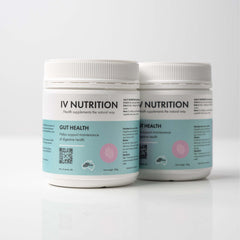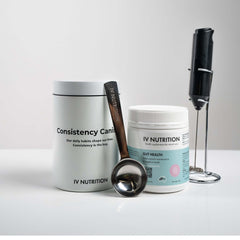How Can I Test My Gut Microbiome?
The gut microbiome is one of the most fascinating areas of modern health research. Housing trillions of bacteria, fungi, and other microorganisms, your gut is more than just a digestive system—it’s a control centre that influences immunity, metabolism, mood, and even skin health.
With this much responsibility, it’s no surprise that people are asking: “How can I test my gut microbiome?” Testing offers a window into the inner ecosystem of your digestive tract, showing which microbes are thriving, which are missing, and how this balance might be affecting your overall health.
In this article, we’ll explore the world of gut microbiome testing: what it is, the methods available, what results can reveal, and how to use the insights to improve your health. We’ll also highlight why prebiotic fibres, such as IV Nutrition’s Virgin Manufactured Sugarcane Prebiotic Fibre, play a key role in restoring microbial balance once you know where you stand.
Why Test Your Gut Microbiome?
The gut microbiome is unique to every individual—like a fingerprint. Some people naturally have higher diversity, while others have imbalances that may contribute to bloating, fatigue, or skin conditions like acne. Testing provides valuable insights by:
-
Identifying microbial diversity levels.
-
Highlighting imbalances, such as too many “bad” bacteria.
-
Showing how your microbiome may be affecting digestion, energy, or immunity.
-
Offering guidance on dietary or lifestyle changes to support a healthier balance.
In short, testing your gut microbiome helps you move from guesswork to evidence-based decisions about your health.
Ways to Test Your Gut Microbiome
Gut testing has become more advanced and more widely available in recent years. Here are the main methods people use:
1. Stool Testing
The most common approach, stool testing involves collecting a sample and sending it to a lab. From there, DNA sequencing techniques identify which microbes are present and in what proportions.
What it shows:
-
Bacterial diversity (good vs. harmful species).
-
Signs of dysbiosis (imbalance).
-
Inflammatory markers or digestion efficiency.
Best for:
General health checks, identifying imbalances, and monitoring progress over time.
2. Metabolite Analysis
Rather than only identifying microbes, some tests measure the byproducts they produce—such as short-chain fatty acids (SCFAs). These metabolites are crucial for gut barrier strength, immune regulation, and inflammation control.
What it shows:
-
How well your microbes are functioning.
-
Levels of protective compounds like butyrate.
Best for:
Understanding the “function” of your microbiome rather than just the “inventory.”
3. Breath Tests
Breath tests measure gases (like methane or hydrogen) produced by gut microbes and exhaled. They are often used to identify small intestinal bacterial overgrowth (SIBO).
What it shows:
-
Overgrowth in areas of the gut where bacteria shouldn’t be.
-
Fermentation patterns.
Best for:
Targeted concerns such as bloating, gas, or suspected overgrowth.
4. Blood Biomarkers (Indirect Testing)
Although not a direct test of the microbiome, blood markers of inflammation, nutrient absorption, or immune activity can suggest gut imbalance.
What it shows:
-
How gut health may be affecting the rest of the body.
Best for:
Holistic health assessments where gut health is suspected but not directly measured.
What Microbiome Tests Can Reveal
A gut microbiome test can offer insights into several key areas of health:
-
Diversity score: A broad range of microbes is usually linked to resilience.
-
Imbalances: Too much of one strain (like harmful Clostridium species) may trigger inflammation.
-
SCFA production: Butyrate and other SCFAs are vital for colon health.
-
Pathogenic presence: Overgrowths of harmful microbes can disrupt digestion and skin health.
-
Dietary feedback: Some tests even suggest which foods to eat more or less of, based on your microbiome profile.
Signs You Might Benefit from Testing
While anyone can test their microbiome, it’s particularly useful if you experience:
-
Ongoing digestive discomfort (bloating, irregularity).
-
Food intolerances or sensitivities.
-
Persistent acne, eczema, or skin inflammation.
-
Fatigue or brain fog.
-
Difficulty losing or maintaining weight.
-
Frequent illness or low immunity.
-
History of long-term antibiotic use.
These issues often stem from an imbalance in the gut ecosystem. Testing helps confirm whether dysbiosis is at play.
What To Do After You Test
A test alone doesn’t fix the problem—it provides the map. The next step is to take targeted action.
1. Adjust Your Diet
-
Increase diversity by eating a wider range of plant foods.
-
Reduce highly processed foods that feed harmful bacteria.
-
Add naturally prebiotic-rich foods like garlic, onions, and bananas.
2. Supplement with Prebiotics
Prebiotic fibres are one of the most effective ways to directly feed beneficial bacteria and increase SCFA production.
3. Manage Lifestyle Factors
Stress, sleep, and hydration all influence the microbiome. Small daily improvements can create noticeable changes in gut balance.
Why Prebiotics Are Key After Testing
Probiotics often get the spotlight, but without prebiotics, probiotics struggle to thrive. Prebiotics act as the fuel for beneficial bacteria, helping them grow, multiply, and perform their protective functions.
Benefits of prebiotics include:
-
Increased microbial diversity.
-
More SCFA production (especially butyrate).
-
Reduced systemic inflammation.
-
Improved bowel regularity.
-
Better immune balance.
If your microbiome test shows low diversity or low SCFA production, prebiotic fibres are often the missing piece.
Spotlight: IV Nutrition’s Virgin Manufactured Sugarcane Prebiotic Fibre
If you’re looking for a clean, effective prebiotic to support gut health after testing, IV Nutrition’s Virgin Manufactured Sugarcane Prebiotic Fibre is a standout choice.
Why It’s Different
-
Virgin manufactured: Extracted directly from sugarcane, not industrial byproducts.
-
Fermentable: Optimised to fuel beneficial microbes and increase SCFA production.
-
Gentle: Well tolerated, even for those with sensitive digestion.
-
Pure: Free from unnecessary additives or fillers.
Benefits for Gut and Whole-Body Health
-
Restores microbial balance.
-
Boosts butyrate levels, strengthening the gut barrier.
-
Improves regularity and reduces constipation.
-
Enhances immune resilience.
-
Supports skin clarity by reducing inflammation.
Special Offer: 100% OFF Your First Tub
Try it risk-free with subscription:
Claim Your Free Tub Here
This makes it one of the simplest, most practical ways to apply insights from microbiome testing.
Practical Tips for Supporting Gut Health
-
Start slow: Introduce prebiotics gradually to let microbes adapt.
-
Stay hydrated: Fibre works best with adequate water intake.
-
Track changes: Notice shifts in digestion, skin, energy, or mood.
-
Retest if needed: Periodic testing can show how your microbiome evolves over time.
The Future of Gut Microbiome Testing
The field is evolving rapidly. Future innovations may include:
-
Real-time at-home testing devices.
-
Personalised prebiotic recommendations based on your unique microbiome.
-
Integration with wearables, linking gut health to sleep, stress, and metabolic markers.
-
Next-generation therapies targeting specific microbial strains for skin, mood, or metabolic health.
Conclusion
So, how can you test your gut microbiome? Options range from stool analysis to metabolite testing and even breath tests for bacterial overgrowth. These tools provide valuable insights into microbial diversity, SCFA production, and potential imbalances.
But the real power lies in what you do with the results. Supporting your gut through diet, lifestyle, and especially prebiotic fibres helps turn information into transformation.
Among supplements, IV Nutrition’s Virgin Manufactured Sugarcane Prebiotic Fibre offers a clean, effective way to fuel beneficial bacteria, boost SCFA production, and restore balance—helping you translate microbiome insights into lasting health improvements.





